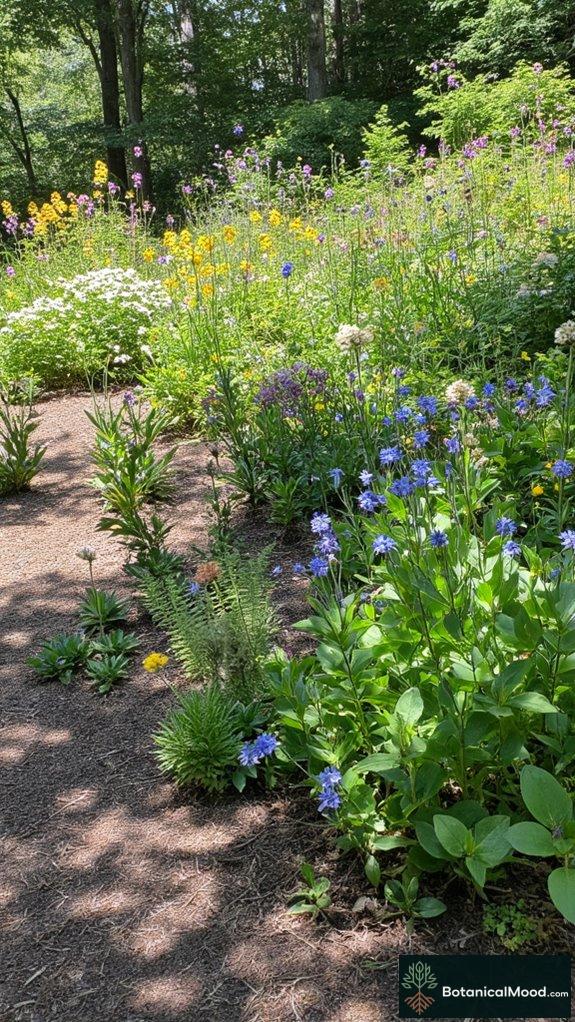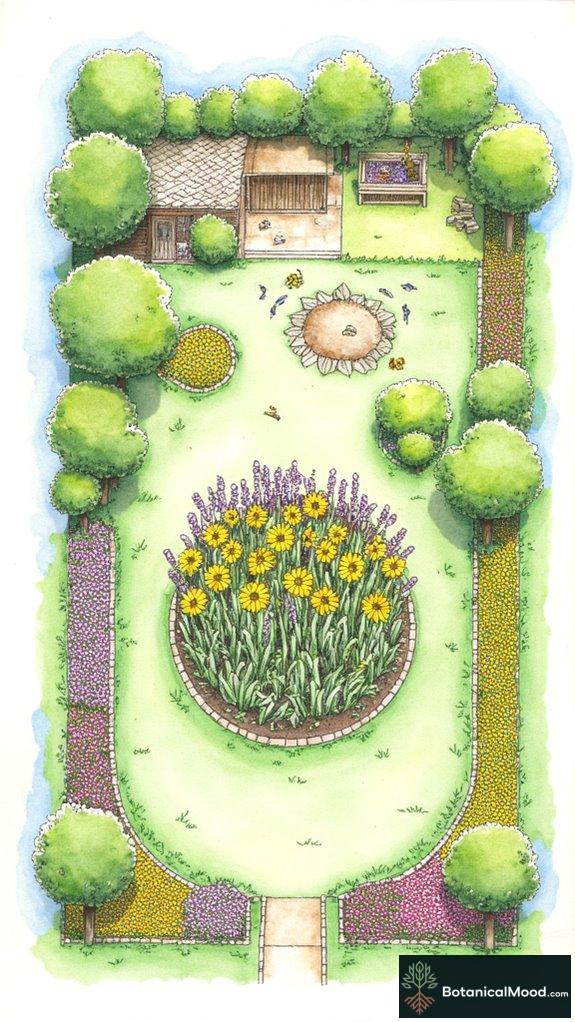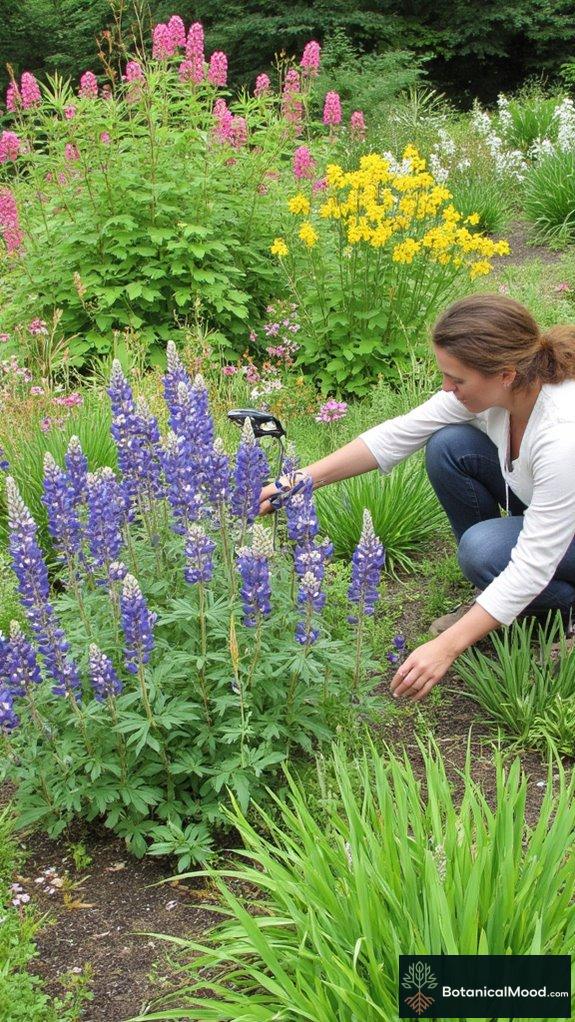Creating a native garden is like throwing an epic party for all the buzzing bees and fluttering butterflies.
Honestly, I used to think native plants were just… well, plants. But then I stumbled upon Echinacea purpurea and Rudbeckia hirta—talk about a color explosion and a nectar buffet!
By mixing tall and short blooms, I found it’s like planting a food truck that’s open all year round.
And let’s not forget those bee hotels. I mean, who doesn’t want a bunch of little buzzing friends staying over?
Want to give it a whirl? You might just start your own pollinator paradise!
Designing My Dream Pollinator Garden: A Transformational Journey
I remember my first attempt at garden design. It was a chaotic mix of random plants—all clashing like a rock band on a classical stage. Then one day, I stumbled upon a vibrant arrangement of native flowers at a local garden center, and it hit me like a light bulb.
Choosing the right plants elevated my space from blah to beautiful. Along the way, I learned about layering, color harmony, and, yes, plant #squadgoals! Now, my garden is buzzing with life. It’s a sanctuary for pollinators, filled with rich colors and textures. I even discovered that planting in clusters increases bee visits. Pro tip: don’t underestimate the power of design—it can transform your garden from a lost cause to a thriving ecosystem.
Quick Takeaways
- Incorporate a diverse array of native plants to provide essential nectar and pollen for various pollinators throughout the growing season.
- Group plants in clusters to create accessible sources of food for bees, butterflies, and other pollinators.
- Select native species with staggered bloom times to ensure a continuous food supply from early spring to late fall.
- Use a combination of plant heights to enhance visual appeal while attracting different types of pollinators effectively.
- Incorporate structures like brush piles and bee hotels, along with water sources, to provide shelter and resources for pollinators.
Selecting Native Plants for Maximum Impact

Have you ever wondered how selecting native plants can create a thriving habitat for pollinators while simultaneously enhancing the beauty of your garden?
When I choose native flora, like Echinacea purpurea or Rudbeckia hirta, I guarantee not only vibrant colors but also an ecosystem that nourishes bees and butterflies. These plants, uniquely adapted to our local climate, demand less water and support biodiversity. By embracing native wisdom and employing regenerative planting methods, I further enrich my garden’s soil health and resilience.
Selecting native plants like Echinacea purpurea and Rudbeckia hirta not only brightens my garden but also supports vital pollinators.
Using different heights and blooming times, I create layers of interest. By incorporating a mix of textures and shades, like the delicate petals of the milkweed alongside the bold hues of goldenrod, I’m not just cultivating a garden; I’m inviting life into my space.
Designing With Nectar and Pollen Diversity

When I intentionally design my garden with a diversity of nectar and pollen sources, I create an inviting haven for pollinators, fostering both beauty and ecological health.
Selecting plants like native coneflowers, bee balm, and goldenrod embraces a rich palette of colors, drawing butterflies and bees with their luscious blooms. Grouping these plants in clusters guarantees easy access to nectar, allowing pollinators to thrive.
I often consider bloom height, form, and texture, pairing spiky asters alongside broad-leafed milkweed, enhancing contrast.
Through thoughtful design, I cultivate a living tapestry that nourishes and delights, embodying the ethos of Botanical Mood in my vibrant environment.
In addition, including a variety of native plant species not only supports local wildlife but also enhances the garden’s resilience to changing environmental conditions.
Creating Year-Round Bloom Sequences

Creating an engaging garden that entices pollinators throughout the year greatly enhances both its aesthetic appeal and ecological value, ensuring a vibrant ecosystem thrives right in my backyard.
To achieve this, I thoughtfully select plants such as crocuses and snowdrops that bloom early, followed by summer delights like coneflowers and bee balm.
As autumn approaches, asters and goldenrods provide essential late-season nectar.
Using native varieties not only enriches the environment but attracts diverse pollinators, including bees, butterflies, and hummingbirds.
This approach to native plant diversity ultimately fosters a thriving habitat that supports long-term sustainability.
Planning bloom sequences transforms my garden into a year-round sanctuary, celebrating nature’s rhythm while inspiring others to embrace biodiversity.
Incorporating Habitat Structures for Pollinators

Pollinators thrive in environments rich in diverse structures that offer shelter, nesting sites, and protection from predators. By incorporating features like brush piles, dead wood, and stone walls, we create inviting spaces for them to thrive. Native grasses and plants such as milkweed or goldenrod not only enhance beauty but also provide crucial habitat. I often find delight in adding bee hotels made from bamboo or untreated wood, offering bees safe spaces for nesting.
Additionally, creating a butterfly habitat garden can further enhance the ecosystem by attracting a wider range of pollinators. Water sources, like small bird baths, can also draw them in. Through thoughtful design, we nurture these indispensable creatures while cultivating a vibrant, flourishing garden.
Understanding Bee Preferences in Plant Choices

How can we best cater to the unique preferences of bees when selecting plants for our gardens? To create a haven for these precious pollinators, we must choose native flowers like coneflowers and bee balm, known for their vibrant colors and enticing nectar.
Bees favor single-petal blooms, allowing easy access to pollen. Incorporating a variety of shapes, sizes, and scents appeals to different bee species, enhancing biodiversity. I find joy in observing their preferences, which inspired me to cultivate diverse plantings.
Minimizing Maintenance With Local Native Species

While many gardeners find joy in nurturing elaborate environments, using local native species can greatly reduce the amount of maintenance needed, allowing for a more sustainable approach.
I’ve discovered that native plants thrive in their natural habitats, needing less watering, fertilizing, and pest control.
This means more time enjoying the beauty of your garden and less time fretting over endless chores.
For example, bee balm (Monarda) and coneflowers (Echinacea) attract pollinators effortlessly.
When I shifted to local flora, the health and vibrance of my garden flourished.
Utilizing Color and Aesthetics in Garden Design

When it comes to garden design, the interplay of color and aesthetics can transform a simple terrain into a breathtaking masterpiece, enchanting both the gardener and the visiting pollinators. By choosing native plants that offer vibrant colors, we create a vivid tapestry that captivates.
Here’s a simple guide to combining aesthetics and functionality:
| Color | Suggested Native Plant |
|---|---|
| Blue | Wild Bluebell |
| Yellow | Cup Plant |
| Purple | Coneflower |
Incorporating these harmonious colors not only brings joy but also guarantees a thriving ecosystem, supporting our fluttering friends.
Engaging the Community in Native Gardening Efforts

What could be more rewarding than witnessing a community come together to embrace the beauty of native gardening?
I’ve found that organizing local workshops and meet-ups fosters connection, as neighbors share plants, seeds, and invaluable perspectives.
Design Strategies for Pollinator Habitats

Creating vibrant pollinator habitats requires a thoughtful approach that not only respects the needs of these essential creatures but also enhances the beauty of our scenery.
Here are some design strategies to take into account:
- Plant Diversity: Incorporate a mix of native species, ensuring blooms from early spring to late fall.
- Nest Support: Include structures like dead wood and bare ground for nesting. Pollinator gardens can utilize unused community open spaces to provide much-needed habitat for these important insects.
- Grouping Plants: Arrange flowers in clumps, allowing easy foraging for pollinators.
- Sunny Spots: Choose bright, open locations to maximize nectar production. By selecting native plants, you not only support local wildlife but also ensure greater adaptability to local conditions, leading to a more resilient garden.
Garden Layout for Pollinators

While balancing aesthetics and ecological functionality may seem challenging, a well-planned garden layout serves as a sanctuary for pollinators and an inviting space for human enjoyment.
I adore positioning my garden in sunny, east-facing spots, letting morning light awaken bees and butterflies.
By arranging plants with height gradients, tall blooms stand proudly at the center, while shorter varieties frame the edges, creating delightful visual harmony.
Arranging plants with height gradients adds visual harmony, showcasing tall blooms in the center and framing shorter varieties beautifully.
I love leaving cozy nooks—leaf piles or wooden stems—where pollinators can nest.
Integrating diverse native plants guarantees that vibrant colors and continuous blooms draw our buzzing friends all season long, creating a thriving ecosystem right at home.
Meet the Garden Designer

Meet the garden designer, Sarah Jenkins, from Portland, Oregon. Her journey into native plant landscaping began with her deep appreciation for the region’s biodiversity and a desire to create a pollinator-friendly environment in her backyard.
To achieve her stunning garden design, Sarah pursued the Grow Native! Professional Certification Program, honing her skills through extensive study and practical application.
The process involved selecting native plants, designing layouts that promote ecological health, and implementing sustainable practices to attract a variety of pollinators.
Using tools from brands like Fiskars and DeWit, Sarah carefully cultivated her garden using high-quality trowels, pruners, and soil amendment equipment.
She also consulted with local horticulturists, including experts from the Portland Native Plant Group, to guarantee the selection and arrangement of plants were ideal for pollinator support.
Popular Pollinator-Friendly Flowers

Pollinator-friendly flowers can bring both vibrant color and ecological benefits to any garden, making them a popular choice for enthusiasts and professionals alike.
Here are four engaging options you might consider:
- Zinnias: Attract butterflies and bloom brightly from summer to frost.
- Sunflowers: Towering beauties that draw honey bees with their abundant nectar.
- Bee Balm: A perennial favorite with its striking tubular blooms, beloved by hummingbirds.
- Purple Coneflower: A native beauty, thriving in varied soils while supporting both bees and songbirds year-round.
In my experience, these selections not only enhance aesthetics but nurture essential pollinator populations, creating a harmonious garden.
References
- https://academic.oup.com/bioscience/advance-article/doi/10.1093/biosci/biaf090/8217021
- https://pmc.ncbi.nlm.nih.gov/articles/PMC7713930/
- http://millionpollinatorgardens.org/wp-content/uploads/2019/09/Million-Pollinator-Garden-Challenge-Report-LOW-RES-FOR-WEB-031719.pdf
- https://createsolutions.tufts.edu/wp-content/uploads/2021/08/CREATE_Pollinators_Murphy_Crone.pdf
- https://www.usda.gov/about-usda/general-information/initiatives-and-highlighted-programs/peoples-garden/importance-pollinators
- https://www.planning.org/pas/quicknotes/96/climate-resilient-pollinator-gardens/
- https://bwsr.state.mn.us/sites/default/files/2019-08/Planting for Pollinators Design Guide 0816.pdf
- https://pollinatorgardens.org/2016/01/12/design-ideas-for-gardeners/
- https://yardzen.com/yzblog/pollinator-garden-design-for-beginners
- https://www.hachettebookgroup.com/storey/designing-pollinator-habitat/
- https://bluethumb.org/wp-content/uploads/sites/2/2021/05/Planting-for-Pollinators-Design-Guide_updated_2020.pdf
- https://wildpollinators-pollinisateurssauvages.ca/2024/06/06/beginner-pollinator-garden-the-3-x-3-x-3-system/
- https://www.onetruckeeriver.org/blog/2021/02/river-friendly-landscaping-planning-a-pollinator-garden
- https://ncipmhort.cfans.umn.edu/ipm-bmp-cultural-control/backyard-landscape-best-management-practices-pollinators
- https://grownative.org/grow-native-professional-certification-program/
- https://www.chicagobotanic.org/adult_education/certificate_programs/garden_design
- https://bulletin.temple.edu/undergraduate/tyler/native-perennial-garden-design-certificate/
- https://www.novatr.com/blog/how-to-become-landscape-designer
- https://www.nativeplanttrust.org/education/certificate-programs/
- https://www.gardenary.com/blog/easy-plants-that-attract-bees-and-butterflies-to-the-garden
- https://www.gardendesign.com/plants/pollinators.html
- https://ncwf.org/habitat/native-pollinator-plants/perennial-annual-flowers/
- https://www.saferbrand.com/articles/top-plants-that-attract-pollinators
- https://www.fws.gov/story/top-plants-your-pollinator-garden

Leave a Reply